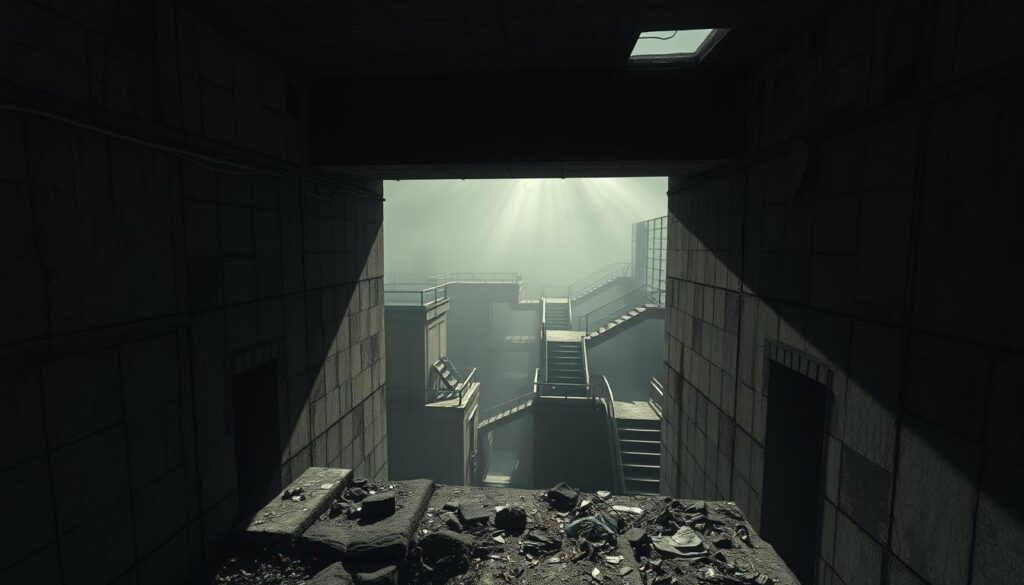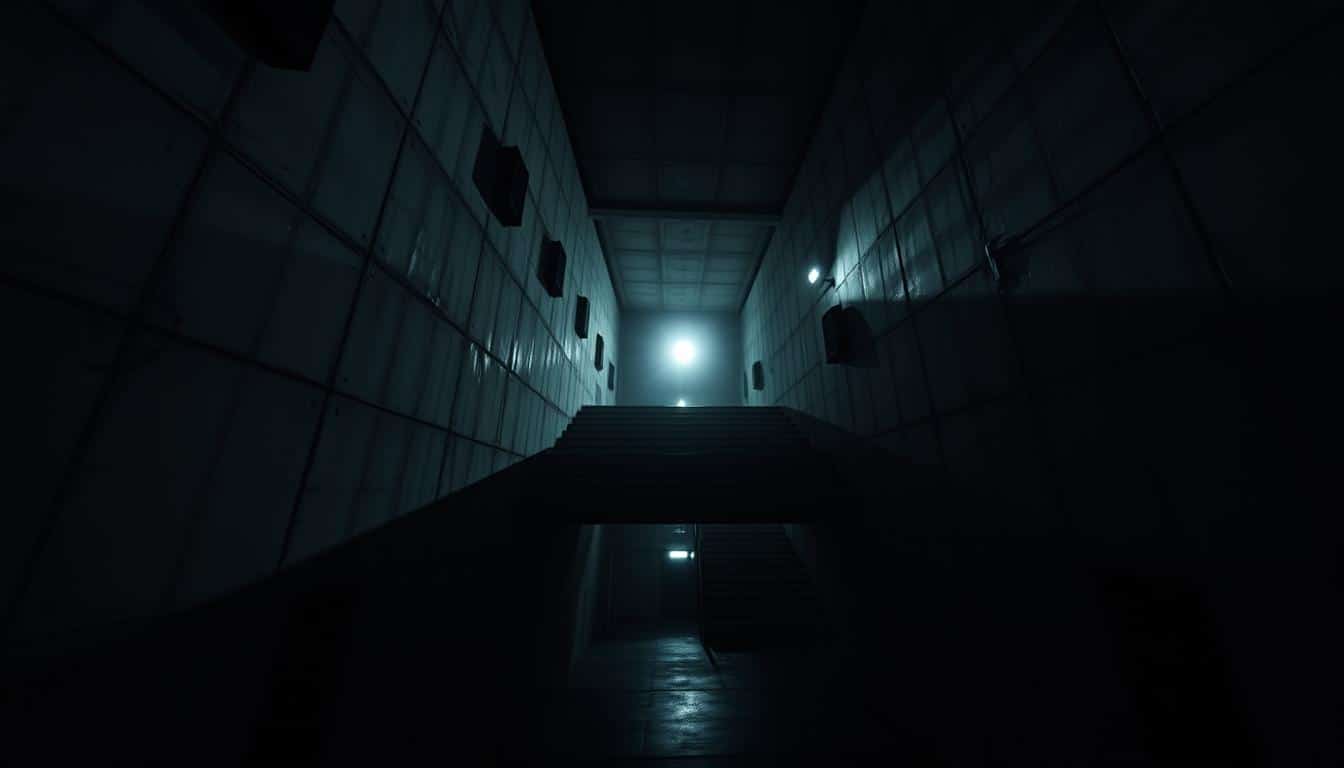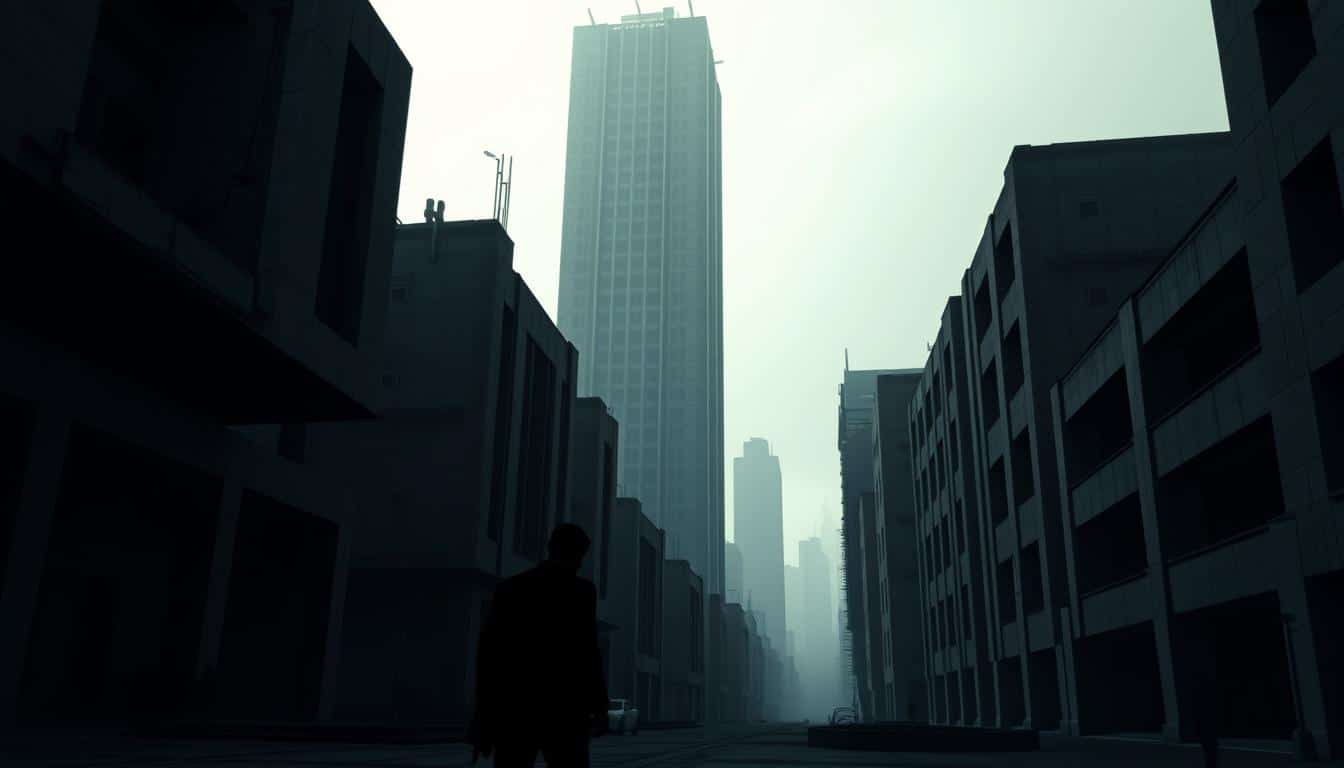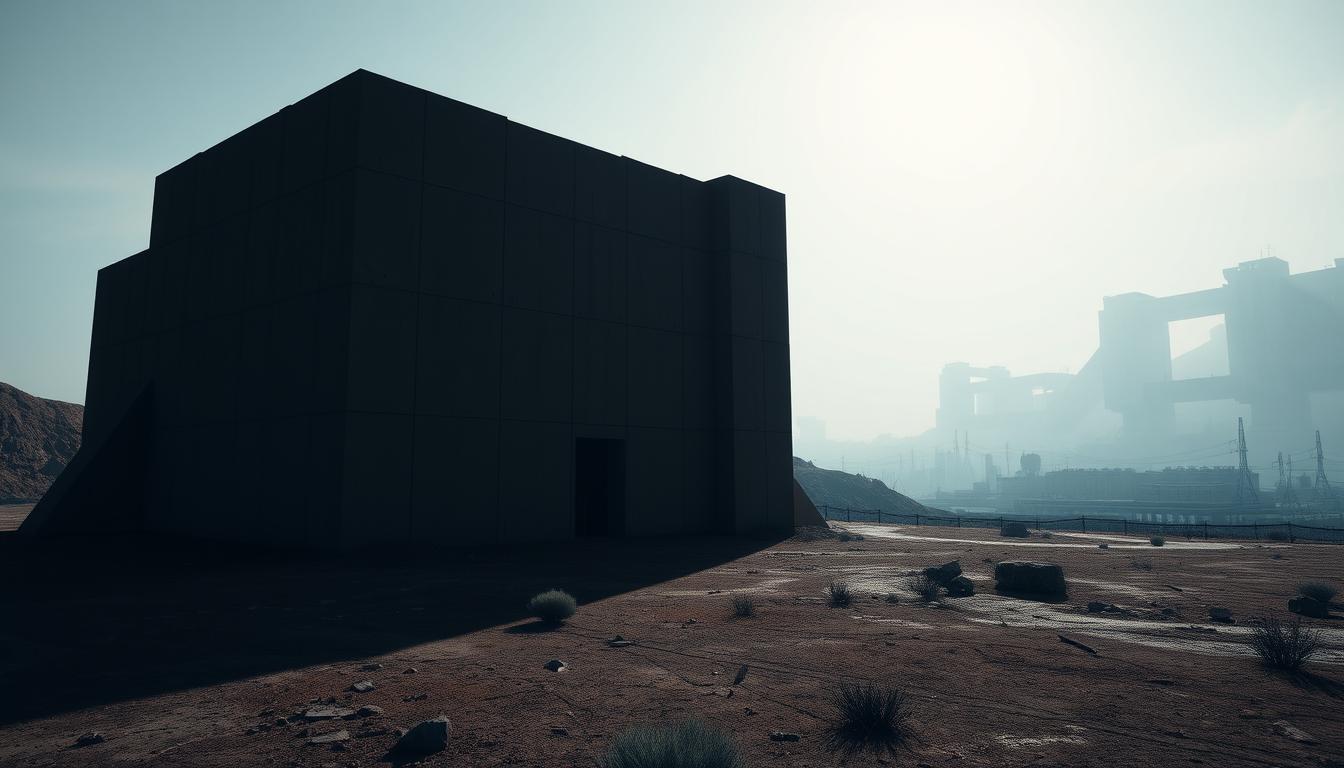Brutalist horror games carve out a special spot in gaming. They stand out by making us feel uneasy. They do this with the scary looks of the games and the stories they tell. These games dive deep into creepy visuals and tackle deep mental and social problems.
This pushes players into stories that make them see things differently and feel deeply. It leads them on an intense adventure through dark themes in games.
When players dive into these games, they explore a world full of fear. They also think deeply about society. This is key to grasping how brutalism affects the horror genre.
The Aesthetic of Brutalist Horror Games
Brutalist horror games are great at making you feel uncomfortable and scared. They use tough, harsh settings that feel empty and heavy. The simple designs and lots of empty spaces make these worlds seem left behind and crumbling.
The atmosphere is key to making you feel this way. Dim lights and muted colors make you feel alone and sad. The graphics make everything seem cold and unwelcoming. The architecture looks raw and undone, like brutalist buildings, making every spot tell a story of destruction and neglect.

The choices in design for these games are not just for show. They pull you into the game on a deep level, mixing environment and story in a powerful way. This mix gives you a memorable experience, letting you face your fears in worlds that are both beautiful and scary.
What is Brutalism in Game Design?
Brutalism in games is about simple, raw-looking visuals and practical use over pretty looks. This style includes strong contrasts and unusual features, which is different from the norm in design principles. Brutalist game design‘s main goal is to make players feel uneasy. It pushes them to deal with topics that can stir up deep feelings.
Here, game makers focus on meaningful themes, creating games that touch the heart. The raw graphics create a disturbing scene. This setting makes players face tough emotions. This approach shakes up usual game playing. It makes players explore places that reflect personal and societal issues.
Key Themes in Brutalist Horror Games
Brutalist horror games take us deep into psychological terror, critiquing society and exploring the human condition. They show characters fighting personal demons and the collapse of society. Players face existential dread in worlds mirroring their own struggles.
These games involve mature themes, tackling subjects like:
- Mental health issues
- Trauma and its effects
- Domestic struggles
- Identity disintegration
- Body horror and its implications
The focus on psychological horror makes the games’ worlds highly immersive. It evokes strong feelings, connecting deeply with players. Through compelling stories, these games offer more than fun. They make meaningful statements about human nature and our personal journeys.
Exploring Brutalist Themes in Horror Video Games
Brutalist horror games dive into complex themes. They blend story and play, making a big impact. These games use their world and people to start talks on big society issues.
Stories told in this way make players think deep about life’s dark sides. They invite players into dark reflections on humanity.
Socio-Economic Commentary and Environmental Storytelling
How a game shows its world is key to talking about society and economy. Designers craft worlds full of real-life details. Games like P.T. show tough realities, like violence and trauma.
The game world itself tells a deep story. It makes players face hard truths about our world.
Psychological Struggles and Body Horror
Psychological themes shine through body horror, hitting deep fears. Games explore mental fights in graphic, sometimes scary ways. Body horror shows the scare of not being in control.
This makes players deal with their fear and deep dread. Through these themes, horror games tell deep stories about being human.
Notable Brutalist Horror Titles to Explore
Some horror games really show off the brutalist look. They blend scare with deep psychological ideas. P.T. and Silent Hill 2 are big names because they changed how we think about horror.
P.T. and Its Psychological Depth
P.T. might be gone from the PlayStation store, but it’s still talked about. It makes players face themes like family violence and domestic abuse. This game takes you in circles, each time peeling back another layer of scary, personal stories.
It changed the game for many developers. They saw how to mix real-life fears with gaming.
Silent Hill 2: A Reflection of Inner Turmoil
Silent Hill 2 takes on brutalist horror in its own way. It’s about the hero’s guilt and sadness. The game draws you into a world that reflects his inner pain.
The scary visuals and sounds make the story’s emotions stronger. This invites players to face what scares them the most. Silent Hill 2 shows that horror can help us understand ourselves better.
The Impact of Sound Design in Brutalist Horror
Sound design plays a big role in horror games. In brutalist horror, careful sound crafting boosts the atmosphere. This makes the environment more immersive, pulling players deeper into the game. They become hyper-aware of every little sound, which ramps up their emotions.
Good sound design has some key parts:
- Ambient sounds: Background noises set the scene and make things feel eerie.
- Character audio: Sounds linked to characters can make things tense and hint at danger.
- Dynamic soundscapes: Changing the sound’s intensity can mirror the game’s pace and build suspense.
Adding these sound elements helps more than just the game’s looks; it improves the story being told. The right audio can make players feel scared and on edge, even if they haven’t seen anything scary yet. As they move through spooky places, great sound design turns their fear into a captivating experience.
The Role of Visuals in Creating Unease
In brutalist horror games, visuals are key to creating unease. Developers use sharp contrasts and eerie images to build a world filled with fear. Places falling apart and simply made add to the feeling of being exposed and vulnerable. The way a game looks and feels horror-wise is vital. It changes how players see the game world.
Lighting and shadows can make safe places look dangerous. They make everything feel unreal. The very careful crafting of these visual parts in horror games raises fear. This tension stays with you as you play. These visuals do more than just decorate; they pull you into the scary story.
Analyze Gameplay Mechanics that Heighten Horror
Horror games use gameplay mechanics to create a scary atmosphere. This is very true in brutalist horror games. Players find they have few resources, making every decision important. They have to move through confusing spaces.
This creates a feeling of being unsafe and scared. The game design mixes psychological horror with the challenge of staying mentally strong.
When the pressure is on, making choices is key. This is because bad choices can have serious downsides. These mechanics make horror games more immersive. Players connect with the story in a deep way. Their choices can change the game’s ending, making their experience better.
These game mechanics make a spine-chilling vibe. They show the mental battles in the horror genre. Every unsure moment makes the game more tense. Players stay focused and realize how bad things are getting. Together, these elements make an intense experience in the world of brutalist horror.
The Future of Brutalist Horror Games
The world of horror gaming is on the brink of change. With new tech like virtual reality, we’re getting closer to the action. This tech lets players dive deep into scary worlds, making every moment more intense. Game creators are now exploring real-life fears and challenges in their stories, making them hit closer to home.
Brutalism in games is getting more personal, focusing on our inner fears. By blending psychological scares with unique game mechanics, these games become eerily real. Players get lost in spooky worlds, learning stories piece by piece. It’s a mix of fear and curiosity that keeps you coming back.
When it comes to looks, horror games are going for simple yet bold styles. They use sharp contrasts and a sense of dread to draw players in. This style speaks to today’s gamers, playing on their deepest fears. Such design choices help keep brutalist horror games exciting and new.
Conclusion
Exploring brutalist themes in horror video games shows how they can deliver deep and reflective experiences. They draw players in with their unique looks and sounds. But they also make people think about issues in the real world.
Brutalism in horror games isn’t just a style; it’s a way to tell stories filled with fear and unease. It takes players on emotional journeys.
The impact of brutalist horror games is growing as gaming evolves. Games like P.T. and Silent Hill 2 use storytelling to explore mental health and society. This genre goes beyond just scaring people, it engages and moves them.
There’s a lot of potential for brutalist horror games to offer meaningful experiences. As games keep changing, developers have a big chance to use these themes. They can mix creativity with storytelling to grab people all over the world.
The future of brutalist horror games looks exciting. They aim to entertain, challenge, and make players think on many levels.



